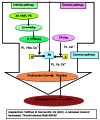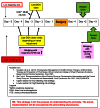Tutorial in oral antithrombotic therapy: biology and dental implications
- PMID: 23524440
- PMCID: PMC3668874
- DOI: 10.4317/medoral.19140
Tutorial in oral antithrombotic therapy: biology and dental implications
Abstract
Objectives: Recent developments of new direct oral anticoagulants that target specific clotting factors necessitate understanding of coagulation biology. The objective of this tutorial is to offer dental professionals a review of coagulation mechanisms and the pharmacodynamics of the conventional and new oral anticoagulants. Also, we summarized the dental implications of the conventional and new anticoagulants.
Method: We searched Medline using search terms "antithrombotic", "antihemostasis" or "anticoagulation" and combined them with the search results of "dental", "oral surgery" or "periodontal". We restricted the results to "human" and "English".
Results: The early coagulation cascade, the new cell-based coagulation model, the pharmacokinetics and pharmacodynamics of conventional antithrombotics, and new oral anticoagulants were reviewed. The new direct factor Xa inhibitors and the direct thrombin inhibitor (s), called direct oral anticoagulants (DOAs) have rapid onset of action, fast elimination on cessation, and fewer drug-drug or drug-food interactions than warfarin. However, the lack of antidotes raises concerns that some dental procedures may trigger serious hemorrhagic events. Additionally, careful perioperative withdrawal and resumption protocols for the DOAs are reviewed, because DOAs' blood levels are dependent on renal function. Also, various reversal strategies in the event of excessive bleedings are summarized. Perioperative management of dental patients taking new DOAs and conventional oral anticoagulants are also discussed. However, the perioperative strategies for DOAs are yet to be validated in randomized trials.
Conflict of interest statement
Figures
Similar articles
-
Potential antidotes for reversal of old and new oral anticoagulants.Thromb Res. 2014 May;133 Suppl 2:S158-66. doi: 10.1016/S0049-3848(14)50026-6. Thromb Res. 2014. PMID: 24862137 Review.
-
New direct oral anticoagulants--current therapeutic options and treatment recommendations for bleeding complications.Thromb Haemost. 2012 Oct;108(4):625-32. doi: 10.1160/TH12-05-0319. Epub 2012 Jul 10. Thromb Haemost. 2012. PMID: 22782297 Review.
-
Management of dental patients receiving antiplatelet therapy or chronic oral anticoagulation: A review of the latest evidence.Eur J Gen Pract. 2017 Dec;23(1):196-201. doi: 10.1080/13814788.2017.1350645. Eur J Gen Pract. 2017. PMID: 28743214 Free PMC article. Review.
-
Role of current and emerging antithrombotics in thrombosis and cancer.Drugs Today (Barc). 2006 May;42(5):331-50. doi: 10.1358/dot.2006.42.5.973580. Drugs Today (Barc). 2006. PMID: 16801996 Review.
-
Surgery and invasive procedures in patients on long-term treatment with direct oral anticoagulants: thrombin or factor-Xa inhibitors. Recommendations of the Working Group on Perioperative Haemostasis and the French Study Group on Thrombosis and Haemostasis.Arch Cardiovasc Dis. 2011 Dec;104(12):669-76. doi: 10.1016/j.acvd.2011.09.001. Epub 2011 Oct 29. Arch Cardiovasc Dis. 2011. PMID: 22152517
Cited by
-
A controlled clinical study of periodontal health in anticoagulated patients: Assessment of bleeding on probing.J Clin Exp Dent. 2017 Dec 1;9(12):e1431-e1438. doi: 10.4317/jced.54331. eCollection 2017 Dec. J Clin Exp Dent. 2017. PMID: 29410759 Free PMC article.
-
Targeting Secondary Hematoma Expansion in Spontaneous Intracerebral Hemorrhage - State of the Art.Front Neurol. 2016 Oct 25;7:187. doi: 10.3389/fneur.2016.00187. eCollection 2016. Front Neurol. 2016. PMID: 27826284 Free PMC article. Review.
-
Bleeding related to dental treatment in patients taking novel oral anticoagulants (NOACs): a retrospective study.Clin Oral Investig. 2019 Jan;23(1):477-484. doi: 10.1007/s00784-018-2458-2. Epub 2018 Apr 25. Clin Oral Investig. 2019. PMID: 29696419
-
Apixaban and oral implications.J Clin Exp Dent. 2015 Oct 1;7(4):e528-34. doi: 10.4317/jced.52470. eCollection 2015 Oct. J Clin Exp Dent. 2015. PMID: 26535102 Free PMC article. Review.
-
Managing dentoalveolar surgical procedures in patients taking new oral anticoagulants.Odontology. 2015 Sep;103(3):258-63. doi: 10.1007/s10266-015-0195-4. Epub 2015 Feb 6. Odontology. 2015. PMID: 25656043 Review.
References
-
- Institute of Medicine (US) Committee on Preventing the Global Epidemic Cardiovascular Diseasel Meeting the Challenges in Developing Countries, Fuster V, Kelly BB. Promoting Cardiovascular Health in the Developing World A Critical Challenge to Achieve Global Health. Washington (DC); National Academies Press (US) 2000;10:397. - PubMed
-
- Kosyfaki P, Att W, Strub JR. The dental patient on oral anticoagulant medication: a literature review. J Oral Rehabil. 2011 ;38:615–33. - PubMed
-
- Lip GY, Tse HF, Lane DA. Atrial fibrillation. Lancet. 2012;379:648–61. - PubMed
-
- Aframian DJ, Lalla RV, Peterson DE. Management of dental patients taking common hemostasis-altering medications. Oral Surg Oral Med Oral Pathol Oral Radiol Endod. 2007 ;103 :S45.e1–11. - PubMed
-
- Devani P, Lavery KM, Howell CJ. Dental extractions in patients on warfarin: is alteration of anticoagulant regime necessary? Br J Oral Maxillofac Surg. 1998 ;36:107–11. - PubMed
Publication types
MeSH terms
Substances
Grants and funding
LinkOut - more resources
Full Text Sources
Other Literature Sources
Medical






